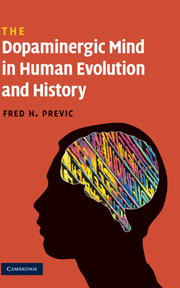Book contents
6 - The dopaminergic mind in history
Published online by Cambridge University Press: 27 July 2009
Summary
If one believes that human evolution – especially in its intellectual aspects – did not rely exclusively or even largely on brain size and genetic transmission, then human evolution has never ceased. Hence, it would be incorrect to assume that all genetically modern humans and societies have the same neurochemistry and therefore the same intellectual abilities, personalities, goals, and propensity toward mental disorder. In particular, there is reason to believe that levels of dopamine are now much higher in members of modern industrialized societies than in more primitive societies. This chapter will focus on two major historical epochs – the transition from the hunter-gatherer societies to the ancient civilizations and the dramatic expansion of the dopaminergic consciousness and lifestyle in the twentieth century. In so doing, this chapter will highlight the role of influential individuals in history who have manifested dopaminergic traits and behaviors and played important roles in shaping our modern dopaminergic world.
The transition to the dopaminergic society
Despite a certain degree of technical proficiency, Neanderthals and even modern humans for their first 100,000 years appear to have lacked the generativity and pervasive “off-line” thinking capabilities of later humans. Once the prehistoric cultural “Big Bang” had progressed to its final stages and the last great Ice Age began to recede around 20,000 years ago, intellectual evolution proceeded at a rapid pace, with seemingly but an instant required from the Neolithic Era and the beginnings of agriculture to the ancient civilizations and the Copper, Bronze, and Iron Ages.
- Type
- Chapter
- Information
- The Dopaminergic Mind in Human Evolution and History , pp. 123 - 154Publisher: Cambridge University PressPrint publication year: 2009

